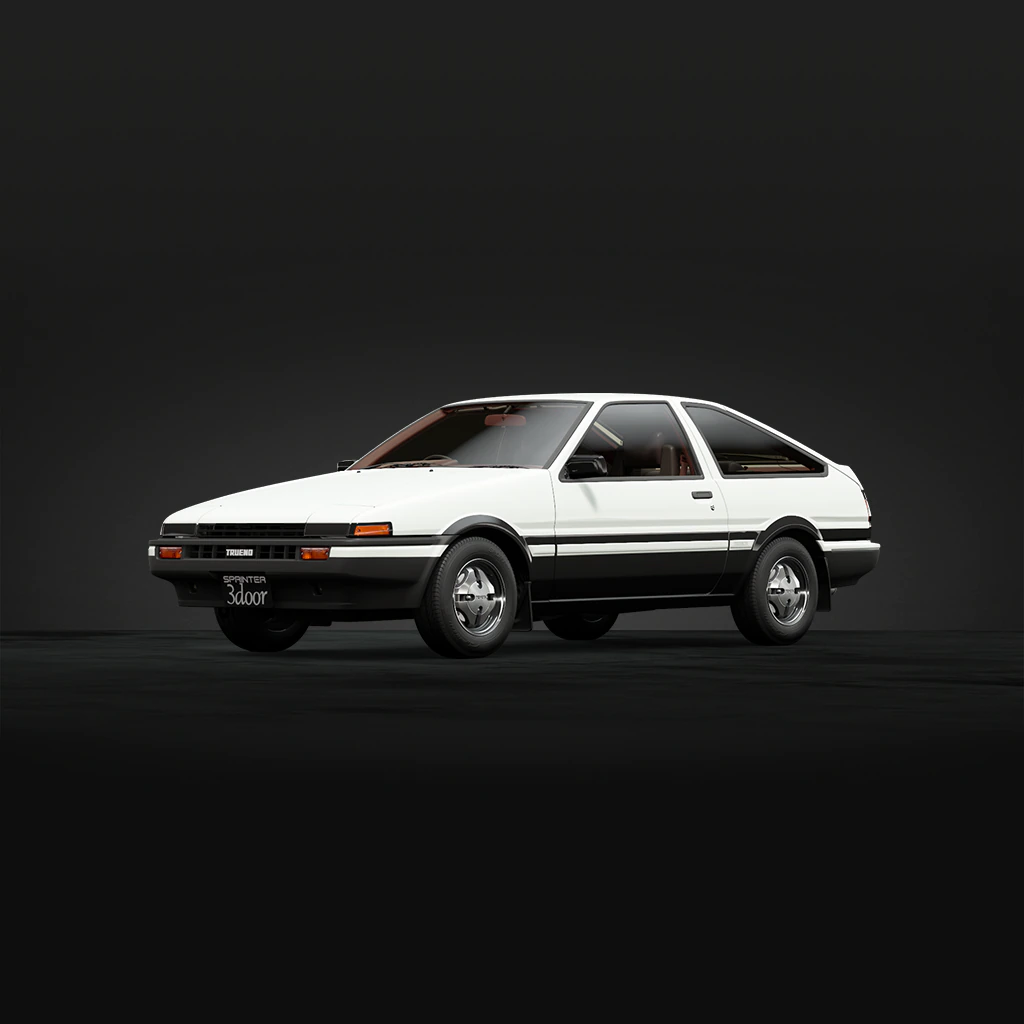The Toyota Corolla AE86 Sprinter Trueno (along with the AE85 Levin) was a huge hit when it was first introduced in May 1983 as a successor to the TE71 (a 3 door coupe based on the Corolla E70 produced from 1979-1983). The car was designed to be a “two-box” coupe, with a front-opening hood and a rear seat. It was a compact, lightweight sports coupe, and a great competitor for the likes of the Honda Prelude and the Mazda RX-7. The AE86 was a major hit whose prominence lasted long after the final one rolled off the production line.
The name “Trueno” deriving its meaning from the Spanish word for “thunder”, while “Levin” derives its meaning from the Old English word “lightning”.
The AE86 is known by many names, “Trueno”, “Sprinter”, “AE86”, but it is also called “hachi-roku” (ハチロク) which is Japanese for “eight-six”. To add even more confusion, there were a few minor aesthetic changes in the middle of the production run signifying the name “zenki” (early period 1983-1985) and those models released in 1986 and 1987 respectively, called “kouki” (latter period).
Power Plant
The AE86 Trueno came equipped with a 4A-GE, which was a fuel injected, naturally aspirated 1.6 liter inline four DOHC with 4 valves per cylinder, with a compression ratio of 9.4:1. The 4-AGE touted a “whopping” 130PS/128HP (later down graded to 120PS/118HP) @ 6,600 RPMs and 110 ft-lbs of torque @ 5,200 RPMs. The 4A-GE used in the AE86 did have a form of variable intake system named “T-VIS“, which helped improve low-end torque by altering the geometry of the intake manifold.
The AE86 Trueno came equipped with a 5 speed manual gearbox, with a later option for a 4 speed automatic, and a optional limited slip differential (LSD).
It truly is a wonder, how this car, with numbers such as these from the factory gained such an iconic status. By today’s standards, even by 1980s standards, it did not come with gobs of power from the factory. The interesting thing about the AE86 Trueno, isnt its power output, but its balance and weight distribution, compounded with its mechanical simplicity of the suspension and steering components. As a matter of fact, it is not in spite of the lack of power, but possibly because of its lack of power it is so popular. It allows a driver to slide out the rear end, but not so much where the driver tends to lose control of the car. It is so nimble and the steering so responsive, that even a novice can get behind the wheel and learn the ins and outs of competitively driving a RWD vehicle. Making reason number 1 why it is so iconic, its the beginner’s perfect car!
The *REAL* DriftKing: Keiichi Tsuchiya
Forget about Fast and Furious: Tokyo Drift, move over fake “DK”. The real “Dorikin” (Drift King or ドリキン) Keiichi Tsuchiya is to drifting what Elvis is to rock and roll! Keiichi-san began his professional racing career in an AE86 Trueno, namely because it was, at the time, an affordable RWD car. In 1987 he won 6 races in a row in the Fuji Freshman series, behind the wheel of his AE86. He was so competitive in his “affordable street car”, he was banned from the event by the organizers stating that the other competitors would “lose interest in competing against him”.
Motorsports
Much for the same reasons as Keiichi-san’s use of the AE86 Trueno, the layout and design and its affordable price allowed it to dominate rally and circuit tracks in which it could compete and remain competitive when placed head-to-head against cars with more power and technological advancements.
Initial D
Of course the most obvious reason for the iconic success of the AE86 is the Japanese anime/manga series which is based on actual Japanese street racers called “hashiriya” (走り屋) who often run their cars on expressways, highways, and as seen on Initial D, on mountain passes (called “touge” literally meaning “pass” in Japanese).
Obviously the most iconic car in the series is Bunta Fujiwara’s Toyota AE86 Sprinter Trueno, driven by his son Takumi. Originally, Takumi-kun starts out making late night Tofu deliveries in the car for his father’s Tofu shop. In order to get this chore done faster he ends up learning how to maneuver the car around the mountain passes in order to get home and back to bed sooner. Eventually he gets good, real good! Eventually he begins to attract the attention of local street racers who want to challenge this “mysterious driver from Mount Akina”. Eventually he does race them, and win. After which he finds an enthusiasm for touge racing and driving in general, as well as love for the iconic Toyota AE86 Sprinter Trueno.
Conclusion
It’s a car that changed the game, back when drifting was still an underground sport. The AE86 Trueno was the car thousands of professional racers can trace their roots back to. The “underdog” but who still came out ahead in many instances. For those of us steeped in Japanese automotive lineage, the AE86 Trueno is an automotive icon, the legend of a past that will not be soon forgotten.

